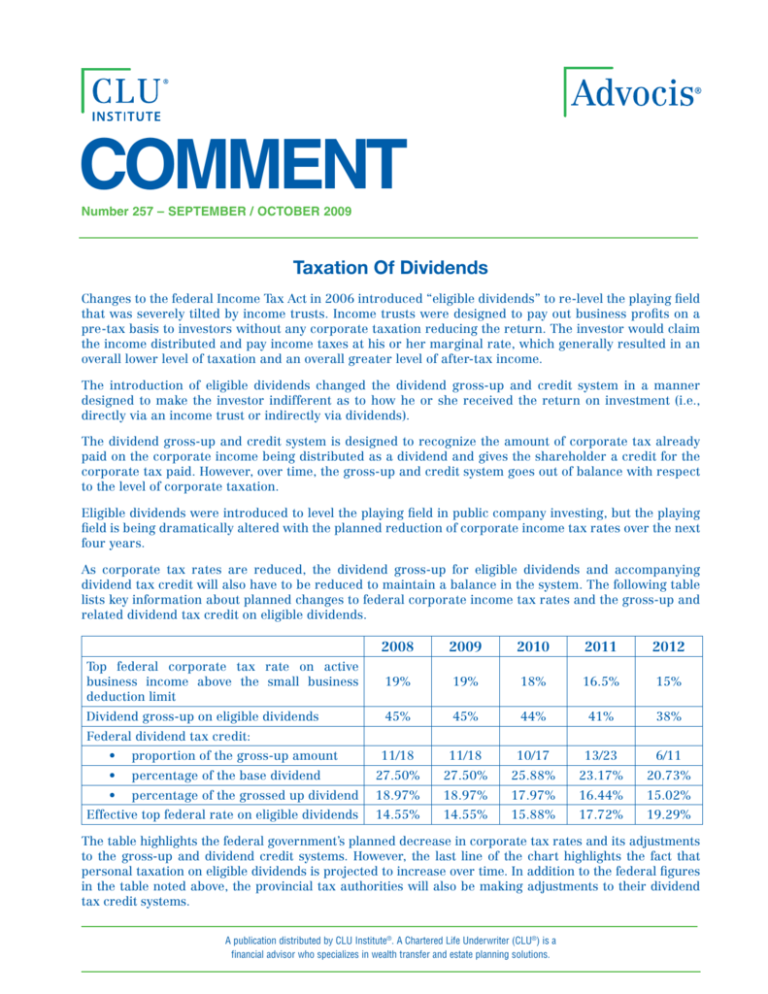
COMMENT
Number 257 – SEPTEMBER / OCTOBER 2009
Taxation Of Dividends
Changes to the federal Income Tax Act in 2006 introduced “eligible dividends” to re-level the playing field
that was severely tilted by income trusts. Income trusts were designed to pay out business profits on a
pre-tax basis to investors without any corporate taxation reducing the return. The investor would claim
the income distributed and pay income taxes at his or her marginal rate, which generally resulted in an
overall lower level of taxation and an overall greater level of after-tax income.
The introduction of eligible dividends changed the dividend gross-up and credit system in a manner
designed to make the investor indifferent as to how he or she received the return on investment (i.e.,
directly via an income trust or indirectly via dividends).
The dividend gross-up and credit system is designed to recognize the amount of corporate tax already
paid on the corporate income being distributed as a dividend and gives the shareholder a credit for the
corporate tax paid. However, over time, the gross-up and credit system goes out of balance with respect
to the level of corporate taxation.
Eligible dividends were introduced to level the playing field in public company investing, but the playing
field is being dramatically altered with the planned reduction of corporate income tax rates over the next
four years.
As corporate tax rates are reduced, the dividend gross-up for eligible dividends and accompanying
dividend tax credit will also have to be reduced to maintain a balance in the system. The following table
lists key information about planned changes to federal corporate income tax rates and the gross-up and
related dividend tax credit on eligible dividends.
2008
2009
2010
2011
2012
Top federal corporate tax rate on active
business income above the small business
deduction limit
19%
19%
18%
16.5%
15%
Dividend gross-up on eligible dividends
45%
45%
44%
41%
38%
11/18
11/18
10/17
13/23
6/11
Federal dividend tax credit:
•
proportion of the gross-up amount
•
percentage of the base dividend
27.50%
27.50%
25.88%
23.17%
20.73%
•
percentage of the grossed up dividend
18.97%
18.97%
17.97%
16.44%
15.02%
Effective top federal rate on eligible dividends
14.55%
14.55%
15.88%
17.72%
19.29%
The table highlights the federal government’s planned decrease in corporate tax rates and its adjustments
to the gross-up and dividend credit systems. However, the last line of the chart highlights the fact that
personal taxation on eligible dividends is projected to increase over time. In addition to the federal figures
in the table noted above, the provincial tax authorities will also be making adjustments to their dividend
tax credit systems.
A publication distributed by CLU Institute®. A Chartered Life Underwriter (CLU®) is a
financial advisor who specializes in wealth transfer and estate planning solutions.
COMMENT
The bottom line is that the eligible dividend system
will remain in a state of flux and that regular
adjustments are needed to meet the purpose of the
gross-up and dividend tax credit mechanism.
I/R 7401.00
Planning Considerations For Students
Every year, parents across the country send their
children off to university and college in search of higher
education. Sometimes the student will be far away
from home, sometimes the student may be close to
home but living separately and sometimes the student
will live at home while attending school locally.
☑ Moving Expenses
Whenever a student heads off to school, there is a
wide range of things to consider. The following is
a checklist of some of the more common financial
concerns impacting post-secondary students:
☑ Tuition, Education and Textbook Tax Credits
☑ Property and Casualty Insurance
Does your home insurance coverage extend to
your child’s school residence or other housing
arrangement? Does your home insurance cover
the student’s possessions as well as damage to
a neighbour’s property caused by negligence
or perhaps an inadvertent mishap? Have you
discussed this with your insurance broker or
insurance company with details specific to your set
of circumstances?
☑ Health & Dental Coverage
Does your group benefit plan at work cover your
child? Do you have to contact your human resource
area to update or inform them that you have an
over-age dependant who is attending school on a
full-time basis? If you have coverage, does your
child want to opt out of the school plan? If you have
coverage and the student also takes coverage under
a school plan, there is the ability to co-ordinate
benefits under the two plans – have you provided
the student with the information needed when
visiting the dentist and/or pharmacist?
☑ Car Insurance
If your child drives a car while at school, has his
or her risk changed? Should you have a discussion
with your broker to ensure that you have complete
and full disclosure of the student’s situation?
Number 257 – September / October 2009
Will your student’s moving expenses be tax
deductible? If so, take the time to gather the
receipts now so that you will be able to find them
at tax filing time.
Students may be eligible to claim the tuition,
education and textbook tax credits. These amounts
can be claimed by the student in the year of study and
unclaimed amounts may be carried over to another
year or transferred to a parent or grandparent.
Ensure your child knows about these credits and sets
aside the appropriate documentation for tax time.
☑ Access to Cash
Does your child have sufficient cash reserves to carry
him or her through the full school year? Parents
often feel a tap on the shoulder for additional money
throughout the year. An option that can make it easy
to assist the student financially is a joint bank account
with one or both of the parents. A parent might have
sufficient rating at the bank such that when he or
she makes a deposit into the joint account, the bank
will not impose any holds on the funds. This can
allow the student to access the funds without delay
and without incurring extra charges.
☑ Establishing a Credit History
Does your child have a credit card? If not, it can
be wise for the child to apply for a student credit
card as it will start the process of building a credit
history. With a credit card in hand, responsibility for
making the regular payments becomes important
to maintaining a good credit rating. Do you need to
monitor that the bill gets paid on time, at least until
you are confident that this task is well in hand? It
is important to ensure that your child’s bills are
paid on time because of the potential interest and
late charges as well as the detrimental effect on the
student’s credit record.
COMMENT
☑ Financial Responsibility
Will your child be liable for utilities at his or her
place of residence? Similar to a credit card, you
need to determine if monitoring the necessary
payments may be helpful initially to ensure good
financial responsibility.
Some, or all, of the above list may apply to your
student’s situation and it is important to determine
which of the issues you feel needs to be addressed.
Once you have considered the issues and your
priorities, it is relatively easy to help get your
student off on a good financial footing and aid in
their financial education.
I/R 2300.00
Refund Of Premiums
The Canada Revenue Agency (CRA) was asked
to comment on the income tax consequences
of a return of premium rider on a life insurance
policy. The particular policy under analysis had
two benefits: first, a life insurance component
that would pay a benefit upon the death of the
life insured and, second, a return of premiums if
death had not occurred during the term of the life
insurance policy contract.
It should be noted that this opinion from the CRA
was in respect of a life insurance policy. At the
time of writing, the Canada Revenue Agency still
does not have an official position on the refund of
premiums of a critical illness policy.
I/R 7401.00, 4400.00
It was the CRA’s view that the benefit received at
the end of the policy duration would be considered
proceeds of disposition. The policyholder would
have to recognize a policy gain to the extent that the
proceeds of disposition exceed his or her adjusted
cost basis in the contract.
A Look At Canadian Spending And Income Patterns
The old adage, that death and taxes are the only
certainties in life, continues to hold true for many
Canadians as Statistics Canada has reported that
Canadian households spent on average 21 per cent
of their budget in 2007 on personal taxes. The three
other necessities in life – shelter, transportation
and food – accounted for an additional 20 per cent,
13 per cent and 10 per cent respectively (based on
a survey of more than 21,000 households).
Charitable donations in 2007 totalled $8.6 billion,
with 5.7 million tax filers having made donations.
The median donation was $250.
Looking at Canadian spending patterns in 2007,
it is interesting to note obvious changes through
time. For example, 71 per cent of Canadian
households reported owning a cellphone with an
average annual household cost of $770. Sixty-one
per cent of households indicated they had a highspeed Internet connection, while only nine per cent
had a dial-up connection. Household spending on
Internet connections averaged $430.
I/R 6851.00
When looking at family budgets and undertaking
financial planning exercises, it is important to
ensure an adequate reflection of true spending
needs – historical patterns are not always good
indicators of the future.
The median contribution to an RRSP in 2007 was
$2,780, with 6.3 million tax filers making some type of
RRSP contribution for a total value of $34.1 billion.
Number 257 – September / October 2009
COMMENT
Subscribe to CLU Comment today at
www.advocis.ca.
Contributors to this issue of Comment:
James W. Kraft, ca, mtax, tep, cfp, clu, ch.f.c.
Deborah Kraft, mtax, tep, cfp, clu, ch.f.c.
Published by:
CLU Institute
390 Queens Quay West, Suite 209,
Toronto, Ontario M5V 3A2
T: 416.444.5251 or 1.800.563.5822
F: 416.444.8031
www.cluinstitute.ca • info@cluinstitute.ca
Number 257 – September / October 2009
This commentary is published by CLU Institute in consultation with an editorial board comprised of
recognized authorities in the fields of law, life insurance and estate administration.
CLU Institute is the professional organization that administers and promotes the Chartered Life
Underwriter of Canada designation.
The articles in CLU Comment are not intended to provide legal, accounting or other advice in
individual circumstances. Seek professional assistance before acting upon information included in
this publication.
Advocis®, CLU® and APA® are trademarks of The Financial Advisors Association of Canada.
Publication Agreement # 40069004
8 For news, comments and more, visit the CLU blog at blog.cluinstitute.ca. 8
Copyright 2009
ISSN 0382-7038
All Rights Reserved







